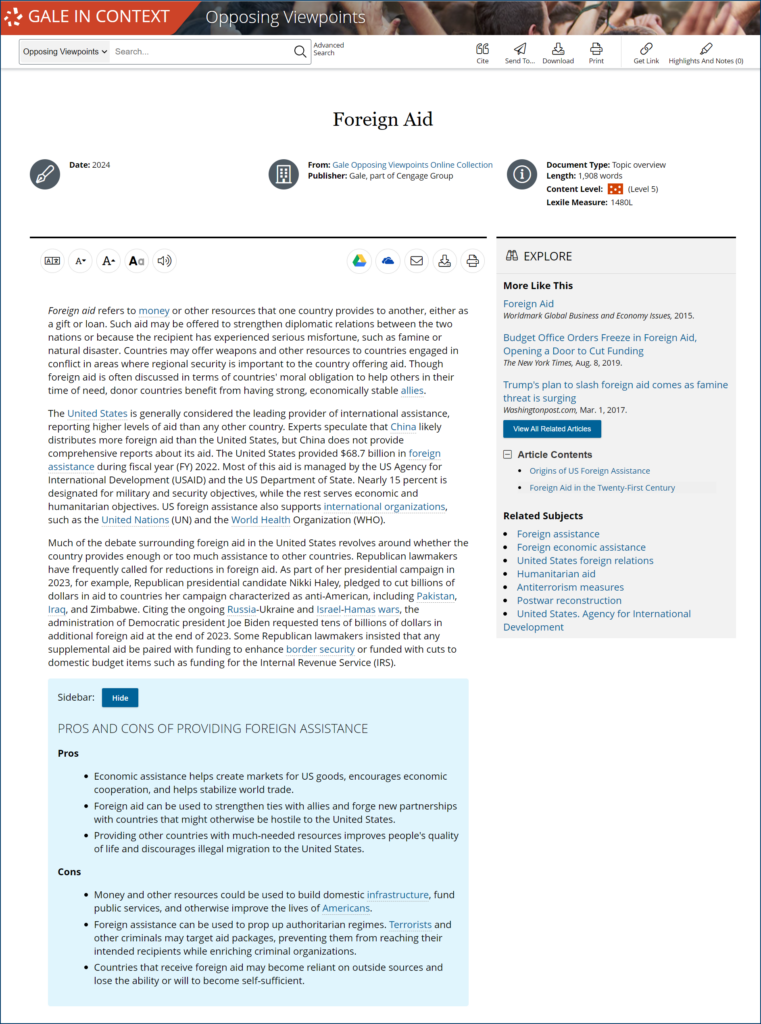| By Gale Staff |
With unobstructed access to international affairs tucked into our pockets, it’s nearly impossible for students to avoid a constant stream of troubling images. A scroll through social media means seeing apartment buildings in Ukraine reduced to rubble by Russian artillery, Gazan skylines left in ruins, and Taiwanese protestors marching for democracy amidst rising tensions with China.
News reporting on sensitive and complicated topics can come with bias, half-truths, and misinformation. Students curious or anxious about these global events might find themselves sifting through these varied narratives, seeking clarity but encountering sources that don’t always present both sides of the issue.
The content available through the Foreign Aid topic page housed in Gale In Context: Opposing Viewpoints presents curriculum-aligned resources without bias. Instead, this trustworthy, educator-vetted repository of information invites learners to explore diverse perspectives and form their own educated opinions about international conflict and our nation’s role in geopolitical issues.
One timely and relevant way to cultivate these critical thinking skills is to examine current legislative efforts, such as the foreign aid package that passed through with a 79-18 Senate vote on April 23, 2024. The $95 billion is allotted for American allies, with $60.8 billion in aid for Ukraine, $26.4 billion to support Israel and provide humanitarian assistance to Gaza, and $8.1 billion for Taiwan.
Evaluating these current events gives real-world context to the concepts students study in civics and history classes, immersing them in the complexities of global affairs and how they relate to America’s objectives in providing foreign aid.
A History of America’s Foreign Aid Policies: From Isolation to Intervention
American thinking about international strategic interests and humanitarian efforts has been in flux since the nation’s founding, from its early days of cautious isolationism to becoming the world’s foremost contributor of foreign aid. As such, students must trace how U.S. foreign aid policies have changed over time to see how past decisions shape current geopolitical dynamics and influence American responses to global concerns.
The timeline provides a few notable examples of these policy decisions to help fuel initial research and discussion into the topic:
1823: President James Monroe opposed European colonialism in the Americas while emphasizing neutrality in European conflicts. This Monroe Doctrine laid the groundwork for a century of American isolationism.
1914–17: The U.S. maintained its policy of neutrality as World War I ripped through Europe, reflecting the continuing isolationist sentiments of the time. It wasn’t until German submarines began sinking ocean liners carrying American passengers that the United States military joined the fight.
1933: President Franklin Delano Roosevelt’s Good Neighbor Policy opened the possibility of pursuing diplomatic relations with countries across Central and Southern America, but continued to emphasize non-intervention and non-interference.
1941: With the passage of the Lend-Lease Act of 1941, the U.S. supplied military aid to Allied nations during World War II while still not formally engaged in combat, blurring the line between isolationism and direct intervention.
1948: In the wake of World War II, the Marshall Plan provided $13.3 billion ($169 billion, adjusted for inflation) to help rebuild European economies, both as a humanitarian effort and as a strategic move to counter Soviet influence during the Cold War.
1961: American foreign aid policies expanded and became more centralized with the founding of the United States Agency for International Development (USAID). In cooperation with the Department of State, USAID administers foreign aid to uphold America’s geopolitical interests and address international humanitarian concerns.
1973: In the wake of the Vietnam War, isolationist sentiment surged, and Congress cut foreign aid spending.
1990–91: Iraq’s invasion of Kuwait during the Gulf War prompted U.S. military intervention with Operation Desert Storm to prevent Iraq from taking control of one-fifth of the world’s oil supply.
2001: After the September 11 attacks, the U.S. significantly increased aid tied to strategic military objectives in Afghanistan and Iraq to combat terrorism and rebuild infrastructure.
2003: President George W. Bush signed the United States Leadership Against Global HIV/AIDS, Tuberculosis, and Malaria Act of 2003 and launched the President’s Emergency Plan for AIDS Relief (PEPFAR). This humanitarian initiative has since provided billions in health aid, furthering the nation’s status as a global leader in combatting public health crises.
2020: U.S. foreign assistance obligations for peace and security funding dropped in favor of health and humanitarian assistance, reflecting our response to the COVID-19 pandemic.
Modern Foreign Aid Objectives
Once students understand the historical evolution of America’s foreign aid policies, they can begin to evaluate the objectives that guide contemporary U.S. efforts in global affairs and how they act as a framework for government involvement. Each objective encompasses a range of sectors intended to support international development and peace, but these often provoke debates about their efficacy and ethical implications.
Learners can use the Gale In Context: Opposing Viewpoints Foreign Aid page as an all-in-one research destination for objective, informational resources. With Gale’s curated collection, teachers don’t need to pre-screen materials or risk inappropriate or inaccurate information.
To give students a launch point to begin their research, it may be helpful to front-load the information by providing a general outline of the arguments for and against each global affairs objective.
Economic and Development Assistance
The Office of Foreign Assistance—the department responsible for supervising and allocating foreign aid programs through the U.S. Department of State and USAID—classifies foreign aid into three categories.
The first is economic and development assistance, which is intended to “advance our national security by helping countries meet near-term political, economic, and development needs.”
As such, economic and development assistance contributes to health, education, agriculture, and infrastructure, fostering stable, prosperous societies that can participate in the global market and are less prone to conflict.
Example Arguments For:
Investments in developing nations can have a positive impact worldwide by creating stable societies less prone to conflict and economic collapse and opening new markets for U.S. trade. There’s also a moral imperative to support health and education efforts because they are necessary steps toward lifting communities out of poverty.
Example Arguments Against:
Domestic issues like healthcare, education, and infrastructure should take precedence over funding improvements for foreign nations. Money spent abroad would be better invested in improving the quality of life at home. Additionally, there’s a danger that we might inadvertently undermine the recipient’s culture and social structure by imposing Western values and economic models that are misaligned with local needs.
Humanitarian Assistance
Humanitarian assistance is designated for supporting “disaster and emergency relief efforts, including programs that save lives, alleviate suffering, and maintain human dignity.”
Organizations use this money to provide immediate relief in crises, such as constructing refugee camps and addressing access to food, clean drinking water, and medical care.
Example Arguments For:
To prevent subsequent issues like mass migration or disease outbreaks, wealthier nations must provide aid to stabilize communities post-disaster. Humanitarian assistance also supports global security efforts by addressing high-stress conditions that can quickly lead to internal conflict.
Example Arguments Against:
These funds might provide short-term relief, but unless we deal with the underlying causes of the crises, we’re only creating cycles of repeated emergencies that require even more funding.
Security Assistance
The final category, security assistance, goes toward “Foster[ing] stability and security abroad by strengthening the military and law enforcement forces in our partner countries through capacity building and training and helps countries purchase defense equipment and services produced in the United States.”
Ukraine’s $60.8 billion aid package partially falls under this category, as some of it will be used for weapons and ammunition.
Example Arguments For:
Aiding allies and participating in peacekeeping missions prevents conflicts from escalating and spreading, which also helps safeguard global stability and security. For example, our decision to assist Ukraine in its efforts to defend its territory against military incursion prevents further regional destabilization that could ripple out into a much larger conflict.
Example Arguments Against:
Intervention in foreign military efforts comes at a cost to taxpayers while diverting resources away from our own crises, like underfunded veteran assistance programs. That money could be used to provide better mental health support services and address the fact that veterans are 1.5 times more likely to commit suicide than the rest of the population.
Our funding of foreign military interests also risks exacerbating conflicts, fueling victory efforts rather than encouraging ceasefires and compromise.
Suggested Discussion Questions
Consider using these discussion prompts to assess learners’ use of evidence in constructing oral arguments or as a pre-writing activity for an argumentative essay.
- U.S. foreign aid seeks to promote peace, but in doing so, it may also foster intra- or international conflict. What measures are necessary to minimize the adverse outcomes of geopolitical intervention?
- What are the long-term impacts of investing in education and health in developing nations? How might these investments influence economic and social dynamics on a global scale?
- Discuss the challenges and opportunities in promoting transparent governance in countries with different cultural and political backgrounds. How can foreign aid support democratic processes without imposing Western values?
- Reflect on the relationship between humanitarian assistance and global environmental changes. How should the U.S. adapt its humanitarian efforts in response to the growing frequency and severity of natural disasters due to climate change?
Prepare Students to Be Engaged Citizens With Gale In Context: Opposing Viewpoints
With the resources available on the Gale In Context: Opposing Viewpoints platform, students can explore some of the most contentious topics impacting our world.
Learners can dig deeper into everything from immigration to automation in the workplace with a wide range of multimedia materials, including: infographics, statistics, videos—and more than 20,000 pro/con viewpoints and 19,000 reference articles. All are presented without bias and within an easy-to-use interface that makes finding the right information a breeze.
Reach out to your local sales representative to learn more about Gale In Context: Opposing Viewpoints and request a free trial.




